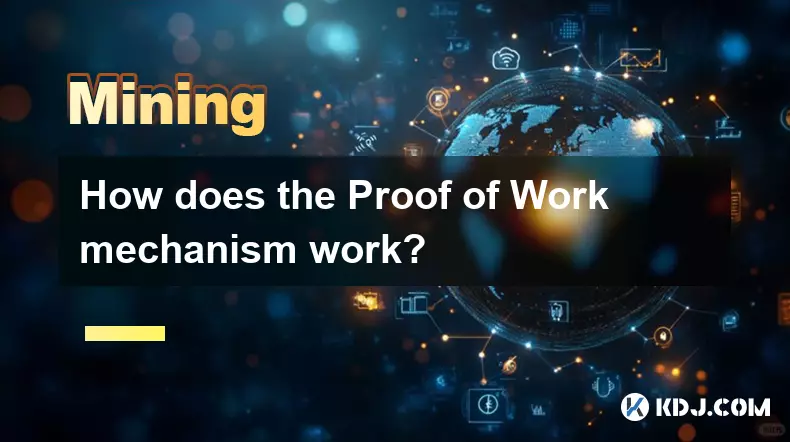-
 bitcoin
bitcoin $122288.232522 USD
0.16% -
 ethereum
ethereum $4480.662914 USD
-0.22% -
 xrp
xrp $2.962747 USD
-2.32% -
 tether
tether $1.000120 USD
-0.05% -
 bnb
bnb $1145.654223 USD
-2.07% -
 solana
solana $227.105217 USD
-1.67% -
 usd-coin
usd-coin $0.999548 USD
-0.02% -
 dogecoin
dogecoin $0.250875 USD
-2.04% -
 tron
tron $0.340654 USD
-0.49% -
 cardano
cardano $0.837968 USD
-2.52% -
 hyperliquid
hyperliquid $48.960449 USD
0.06% -
 chainlink
chainlink $22.049280 USD
-1.33% -
 ethena-usde
ethena-usde $1.000404 USD
0.02% -
 sui
sui $3.586212 USD
0.20% -
 avalanche
avalanche $29.894916 USD
-4.18%
How does the Proof of Work mechanism work?
Proof of Work secures blockchains by requiring miners to solve complex puzzles, ensuring trust through computational effort and economic incentives.
Sep 22, 2025 at 12:54 pm

Understanding the Basics of Proof of Work
1. Proof of Work (PoW) is a consensus algorithm used in blockchain networks to validate transactions and create new blocks. It requires participants, known as miners, to solve complex mathematical puzzles using computational power. The first miner to solve the puzzle gets the right to add a new block to the blockchain.
2. These mathematical problems are designed to be difficult to solve but easy to verify once a solution is found. This ensures that malicious actors cannot easily manipulate the network, as altering any block would require redoing the work for that block and all subsequent blocks.
3. The difficulty of the puzzles automatically adjusts based on the total network computing power, maintaining a consistent block creation time. For example, Bitcoin targets a new block every ten minutes, regardless of how many miners are active.
4. Miners invest in high-performance hardware such as ASICs or GPUs to increase their chances of solving the puzzle first. This investment acts as a deterrent against dishonest behavior, as attacking the network would require an enormous amount of resources.
5. Once a miner finds a valid solution, it broadcasts the block and proof to the network. Other nodes quickly verify the solution’s correctness and, if valid, accept the block into their copy of the blockchain.
Rewards and Incentives in PoW Systems
1. To encourage participation, miners receive rewards in the form of newly minted cryptocurrency and transaction fees from users. In Bitcoin, the block reward halves approximately every four years in an event known as the halving.
2. These incentives align the interests of miners with the security and stability of the network. Honest mining becomes more profitable than attempting to defraud the system.
3. Transaction fees play an increasingly important role as block rewards decrease over time. Users can prioritize their transactions by offering higher fees, which miners are more likely to include in the next block.
4. The competitive nature of mining leads to constant innovation in hardware efficiency and energy optimization, although this has also raised concerns about environmental impact.
5. The economic model behind PoW ensures long-term network sustainability by balancing scarcity, incentive, and decentralization.
Security Features of Proof of Work
1. One of the most significant advantages of PoW is its resistance to Sybil attacks, where a single entity creates multiple fake identities to gain control. Because each identity must perform real computational work, creating numerous fake nodes becomes prohibitively expensive.
2. Achieving majority control of the network—commonly referred to as a 51% attack—requires owning more than half of the total hashing power. Such an attack would demand immense financial and technical resources, making it impractical for well-established chains like Bitcoin.
3. Even if a 51% attack were launched, the attacker could only reverse their own transactions or prevent new ones from being confirmed. They could not steal funds from others’ wallets or create coins out of thin air beyond the protocol rules.
4. The immutability of the blockchain is reinforced by the cumulative work embedded in each block. Rewriting history would require redoing all the work from the altered block onward, which grows more difficult as the chain extends.
5. The inherent cost of computation serves as a powerful deterrent against malicious activity, making PoW one of the most battle-tested security models in decentralized systems.
Frequently Asked Questions
What prevents miners from cheating in a Proof of Work system?Miners cannot cheat because every node in the network independently verifies the validity of transactions and the correctness of the proof. Any invalid block is immediately rejected, wasting the miner's effort and electricity without reward.
Why does Proof of Work consume so much energy?PoW consumes substantial energy because it relies on real-world computational work to secure the network. The energy expenditure is proportional to the value protected, ensuring that attacks are economically irrational. This energy use is a feature, not a flaw, of the security model.
Can small miners still compete in Proof of Work networks?Individual small miners often join mining pools to combine their computational power and share rewards proportionally. While large-scale operations dominate due to economies of scale, pooled mining allows smaller participants to remain involved and earn consistent returns.
How does Proof of Work differ from Proof of Stake?Proof of Work requires computational effort to validate blocks, while Proof of Stake selects validators based on the amount of cryptocurrency they hold and are willing to 'stake' as collateral. PoW emphasizes external resource expenditure, whereas PoS relies on internal economic incentives.
Disclaimer:info@kdj.com
The information provided is not trading advice. kdj.com does not assume any responsibility for any investments made based on the information provided in this article. Cryptocurrencies are highly volatile and it is highly recommended that you invest with caution after thorough research!
If you believe that the content used on this website infringes your copyright, please contact us immediately (info@kdj.com) and we will delete it promptly.
- BlockDAG, DOGE, HYPE Sponsorship: Crypto Trends Shaping 2025
- 2025-10-01 00:25:13
- Deutsche Börse and Circle: A StableCoin Adoption Powerhouse in Europe
- 2025-10-01 00:25:13
- BlockDAG's Presale Buzz: Is It the Crypto to Watch in October 2025?
- 2025-10-01 00:30:13
- Bitcoin, Crypto, and IQ: When Genius Meets Digital Gold?
- 2025-10-01 00:30:13
- Stablecoins, American Innovation, and Wallet Tokens: The Next Frontier
- 2025-10-01 00:35:12
- NBU, Coins, and Crypto in Ukraine: A New Yorker's Take
- 2025-10-01 00:45:14
Related knowledge

The difference between staking and mining
Sep 24,2025 at 05:18am
Understanding Staking in the Cryptocurrency Ecosystem1. Staking involves holding funds in a cryptocurrency wallet to support the operations of a block...

How to participate in testnet mining?
Sep 22,2025 at 09:18am
Understanding Testnet Mining in the Crypto Ecosystem1. Testnet mining is a method used by blockchain developers to simulate real-world conditions on a...

How to dispose of abandoned mining machines?
Sep 19,2025 at 08:19pm
Assessing the Condition of Abandoned Mining Rigs1. Begin by inspecting each mining machine for visible damage, corrosion, or missing components. Machi...

How to identify high-quality mining pools?
Sep 21,2025 at 03:19pm
Reputation and Track Record1. A mining pool’s reputation is built over time through consistent performance and transparency. Pools that have operated ...

Advantages of decentralized mining pools
Sep 20,2025 at 04:36pm
Enhanced Security and Resistance to Censorship1. Decentralized mining pools operate on blockchain-based smart contracts, eliminating the need for a ce...

What is mining machine overclocking?
Sep 21,2025 at 07:19pm
Understanding Mining Machine Overclocking1. Mining machine overclocking refers to the process of increasing the operating frequency of a cryptocurrenc...

The difference between staking and mining
Sep 24,2025 at 05:18am
Understanding Staking in the Cryptocurrency Ecosystem1. Staking involves holding funds in a cryptocurrency wallet to support the operations of a block...

How to participate in testnet mining?
Sep 22,2025 at 09:18am
Understanding Testnet Mining in the Crypto Ecosystem1. Testnet mining is a method used by blockchain developers to simulate real-world conditions on a...

How to dispose of abandoned mining machines?
Sep 19,2025 at 08:19pm
Assessing the Condition of Abandoned Mining Rigs1. Begin by inspecting each mining machine for visible damage, corrosion, or missing components. Machi...

How to identify high-quality mining pools?
Sep 21,2025 at 03:19pm
Reputation and Track Record1. A mining pool’s reputation is built over time through consistent performance and transparency. Pools that have operated ...

Advantages of decentralized mining pools
Sep 20,2025 at 04:36pm
Enhanced Security and Resistance to Censorship1. Decentralized mining pools operate on blockchain-based smart contracts, eliminating the need for a ce...

What is mining machine overclocking?
Sep 21,2025 at 07:19pm
Understanding Mining Machine Overclocking1. Mining machine overclocking refers to the process of increasing the operating frequency of a cryptocurrenc...
See all articles










































































